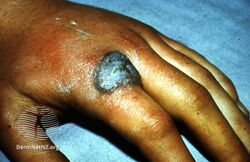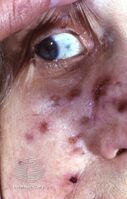Cutaneous tuberculosis
Jump to navigation
Jump to search
| Cutaneous tuberculosis | |
|---|---|
 | |
| Cutaneous tuberculosis | |
| Specialty | Dermatology |
| Frequency | Lua error in Module:PrevalenceData at line 5: attempt to index field 'wikibase' (a nil value). |
Cutaneous tuberculosis is an infection due to M. tuberculosis complex, and bacillus Calmette-Guérin. Clinical presentation depends on immunity and also environmental aspects; as well as those individuals using immunobiological drugs who may be susceptible.[1][2]
Additional images
-
Cutaneous tuberculosis
-
Cutaneous tuberculosis
-
Cutaneous tuberculosis
See also
References
- ↑ Dias, Maria Fernanda Reis Gavazzoni; Bernardes Filho, Fred; Quaresma, Maria Victória; Nascimento, Leninha Valério do; Nery, José Augusto da Costa; Azulay, David Rubem (December 2014). "Update on cutaneous tuberculosis". Anais Brasileiros de Dermatologia. 89 (6): 925–938. doi:10.1590/abd1806-4841.20142998. Archived from the original on 28 August 2021. Retrieved 17 June 2021.
- ↑ Hill, Michael K.; Sanders, Charles V. (January 2017). "Cutaneous Tuberculosis". Microbiology Spectrum. 5 (1). doi:10.1128/microbiolspec.TNMI7-0010-2016. ISSN 2165-0497. Archived from the original on 28 August 2021. Retrieved 17 June 2021.
Further reading
- Charifa, Ahmad; Mangat, Rupinder; Oakley, Amanda M. (2021). "Cutaneous Tuberculosis". StatPearls. StatPearls Publishing. Archived from the original on 28 August 2021. Retrieved 17 June 2021.


